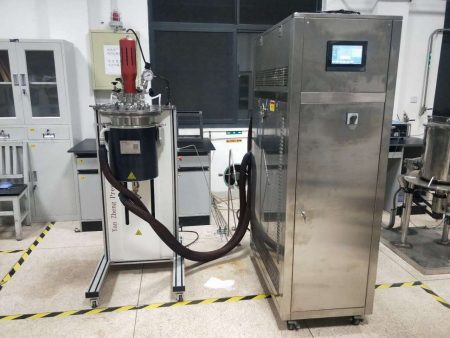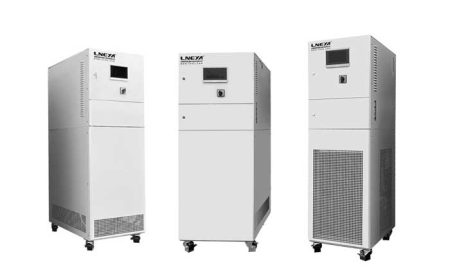Closed Loop Glycol Cooling System
The closed loop glycol cooling system is a chiller that uses ethylene glycol as the secondary refrigerant of the chiller. Sometimes the cooling liquid needs to be below 0℃. If it is cooled with water, it will freeze. Adding antifreeze liquid can avoid freezing, and ethylene glycol can prevent freezing.
Working principle of closed loop glycol cooling system:
Install a plate heat exchanger outdoors, and a fan will introduce the outdoor cold air into the plate heat exchanger. The ethylene glycol solution and the outdoor cold air will exchange heat in the plate heat exchanger. The cooled ethylene glycol solution enters the air conditioning unit in the inner area, where it exchanges heat with the mixed air. The mixed air is cooled, and after the temperature drops, it enters the inner room to provide cooling to the inner room. The temperature of the ethylene glycol solution rises and returns to the outdoor plate heat exchanger again to exchange heat with the cold outdoor air. After the temperature drops, the cycle continues. This type of heat exchange is often used in heat recovery systems. Ethylene glycol exchanges heat with high-temperature exhaust air. After the temperature rises, it enters the fresh air cabinet to preheat the fresh air. Thus, the heat in the exhaust air is recovered to heat the fresh air, saving electric energy and operating costs.
This method of using ethylene glycol solution as a secondary refrigerant to introduce the cold energy in the outdoor cold air to provide cooling to the inner area is a very energy-saving air conditioning method. Just install a plate heat exchanger outdoors. During operation, the chiller is turned off and only the fan and air conditioning unit are turned on to introduce natural cold sources to provide cooling to the inner area, saving electricity and reducing operating costs. However, in the process of using outdoor cooling to provide cooling to the inner area, the cold air needs to exchange heat with ethylene glycol, and then the ethylene glycol needs to exchange heat with the mixed air. After two heat exchanges, the cooling capacity loss is large. , the heat transfer efficiency is not high, generally less than 60%.

Advantages of closed loop glycol cooling system
1. Environmental friendliness
As a natural organic compound, ethylene glycol is environmentally friendly and renewable. Compared with traditional refrigerants, ethylene glycol does not cause damage to the atmosphere and does not produce a greenhouse effect on the earth, so it plays a positive role in reducing global warming and protecting the environment.
2. Security
As a non-toxic, odorless and non-irritating compound, ethylene glycol has high safety. In contrast, traditional refrigerants such as ammonia and Freon are highly toxic and corrosive, and there are potential safety risks during use. The use of ethylene glycol refrigerant refrigeration system can reduce these risks and ensure the safety of personnel.
3. High energy efficiency
Ethylene glycol secondary refrigerant refrigeration system has high energy efficiency. Ethylene glycol has a low vaporization temperature and high heat absorption capacity, and can quickly absorb heat during the refrigeration process and achieve a refrigeration effect. In comparison, traditional refrigerants have poor heat conduction capabilities, and the refrigeration process takes longer and consumes more energy.
Ofrecemos diseño y fabricación de sistemas completos de control de temperatura. Desde modelos estándar hasta productos personalizados completos de hasta 900 toneladas. Nos especializamos en el servicio al cliente y nos dedicamos a ayudar a cada cliente a tener el sistema de control de temperatura óptimo para su necesidad específica.
Ofrecemos soluciones personalizadas no estándar. Disponemos tanto de enfriadoras individuales como de unidades combinadas de refrigeración y calefacción.
Correo electrónico: info@lneya.com WeChat ID: +8615251628237 WhatsApp: +86 17851209193

Enfriadoras de recirculación / Criotermostatos
El enfriador puede utilizarse ampliamente en diversas industrias y laboratorios, y admite diseños personalizados.
| Temperatura | Serie -25°C ~ +30°C | Serie -45°C ~ +30°C | Serie -60°C ~ -20°C | Serie -80°C ~ -20°C | Serie -120°C ~ -70°C | ||||
| Capacidad de refrigeración | 0,8 ~ 30 kW | 0,75 ~ 12 kW | 0,4 ~ 6kW | 0,2 ~ 6kW | 0,3 ~ 5kW | ||||
| Nota: Se puede personalizar cualquier rango de temperatura de -150℃ ~ +350℃ y cualquier capacidad de refrigeración. | |||||||||
 Enfriadoras de agua / Enfriadoras pequeñas
Enfriadoras de agua / Enfriadoras pequeñas
El enfriador puede utilizarse ampliamente en diversas industrias y laboratorios, y admite diseños personalizados.
| Temperatura | -18°C ~ +30°C | Serie +5°C ~ +35°C | |||||||
| Capacidad de refrigeración | 0,35 ~ 0,9 kW | 1,8 ~ 50 kW | |||||||
| Nota: Se puede personalizar cualquier rango de temperatura de -150℃ ~ +350℃ y cualquier capacidad de refrigeración. | |||||||||

Refrigeradores de baja temperatura
Estamos especializados en la producción de refrigeradores de baja temperatura con un rango de control de temperatura de hasta -150°C, que pueden satisfacer las necesidades de refrigeración de diferentes industrias.
| Temperatura | Serie -25°C ~ -5°C | Serie -45°C ~ -10°C | Serie -60°C ~ -10°C | Serie -80°C ~ -30°C | Serie -110°C ~ -50°C | Serie -150°C ~ -110°C | |||
| Capacidad de refrigeración | 12 ~ 360 kW | 6 ~ 180 kW | 6 ~ 180 kW | 4 ~ 180kW | 2 ~ 120kW | 2,5 ~ 11 kW | |||
| Nota: Se puede personalizar cualquier rango de temperatura de -150℃ ~ +350℃ y cualquier capacidad de refrigeración. | |||||||||

Refrigeradores de alta temperatura
El enfriador puede utilizarse ampliamente en diversas industrias y laboratorios, y admite diseños personalizados.
| Temperatura | +5°C ~ +40°C | -25°C ~ +40°C | -45°C ~ +40°C | -80°C ~ +80°C | -100°C ~ +80°C | ||||
| Capacidad de refrigeración | 6 ~ 40kW | 2 ~ 15kW | 1 ~ 8kW | 0,6 ~ 3 kW | 1,5 ~ 3 kW | ||||
| Nota: Se puede personalizar cualquier rango de temperatura de -150℃ ~ +350℃ y cualquier capacidad de refrigeración. | |||||||||

Enfriadoras y calefactoras
Rango de control de temperatura: -120°C a +350°C
termostato de refrigeración y calefacción, ampliamente utilizado en diversas industrias.
| Temperatura | Serie -10 ~ +150°C | Serie -25 ~ +200°C | Serie -25 ~ +300°C | Serie -45 ~ +250°C | Serie -45 ~ +300°C | Serie -60 ~ +250°C | Serie -60 ~ +300°C | Serie -70 ~ +250°C | Serie -80 ~ +250°C | Serie -90 ~ +250°C | Serie -100 ~ +100°C | ||
| Capacidad de refrigeración | 1,5 ~ 15 kW | 1 ~ 200 kW | 1 ~ 200 kW | 0,45 ~ 200 kW | 0,9 ~ 25 kW | 0,25 ~ 60 kW | 0,75 ~ 25 kW | 0,4 ~ 15 kW | 0,3 ~ 80 kW | 0,2 ~ 80 kW | 0,45 ~ 80 kW | ||
| Nota: Se puede personalizar cualquier rango de temperatura de -150℃ ~ +350℃ y cualquier capacidad de refrigeración. | |||||||||||||

Enfriadoras de recirculación
Rango de control de temperatura: -45°C a +250°C
| Temperatura | Serie -25°C ~ +200°C | Serie -45°C ~ +250°C | |||||||
| Capacidad de refrigeración | 1 ~ 15 kW | 0,25 ~ 15 kW | |||||||
| Nota: Se puede personalizar cualquier rango de temperatura de -150℃ ~ +350℃ y cualquier capacidad de refrigeración. | |||||||||
 LNEYA
LNEYA
 简体中文
简体中文


















































































